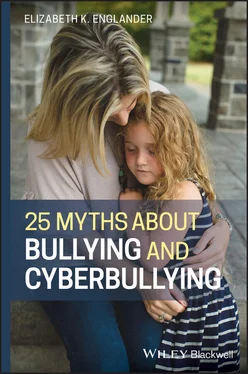Just because psychological tactics predominate, though, doesn't mean they're all the same. The precise behaviors that children use to bully vary notably, depending upon the environment where they occur. In school, kids primarily bully through the use of psychological behaviors that express contempt or dismissiveness – for example, they might ignore a person who's speaking to them, laugh meanly at someone, or roll their eyes when an opinion is voiced or an answer is wrong. In research, we call these gateway behaviors , because frequent and widespread expressions of contempt are the “gateway” to more toxic and unpleasant social climates. One form of this is (particularly among girls) relational aggression , which is bullying or cruelty in which the aggressor takes action to interfere with friendships or torpedo another's relationships as a way of hurting the target. 12 In digital realms (online in gaming and social media, or through exchanging digital messages such as text messaging), psychological bullying might feature biting comments, threats, or public humiliation. Digital bullying can be relational and/or contemptuous. Both in school and online, though, the single most common type of meanness and bullying is often both relational and contemptuous: spreading gossip and rumors, which may or may not be true and which can enormously impact friendships. (In virtually every school where my students and colleagues at the Massachusetts Aggression Reduction Center work, rumors and gossip play a key, prominent role in making life difficult for the students [by their own admission].) The primary challenge in reducing gossip and rumors is (not to put too fine a point on it) its self‐reinforcing nature. The fact is, it's fun to gossip. And that makes it hard to resist, and hard to suppress.
All of these things – gateway behaviors, relational aggression, and digital meanness – are relatively common in childhood and adolescence. But please note (and this is important!):
I'm not saying that every rumor, or every contemptuous behavior, necessarily constitutes bullying.
More often than not, gateway behaviors are used just to be mean (perhaps without really thinking), to show off, or when two kids are fighting and mad at each other. In other words, bullying is only one reason kids would use these behaviors. Characterizing every eye roll as bullying would be crazy; but it's not crazy to say that eye‐rolling is one way of making a victim of bullying feel terrible, and a way of continuing the saga of cruelty against them. When gateway behaviors are used sporadically or in isolation, the hurt is likewise transient. But if they're used as part and parcel of an ongoing campaign to make someone's life miserable, the impact is often much more potent.
One challenge that's interesting to me is how two‐faced we are as a society about gateway behaviors and relational aggression. On the one hand, generally speaking, our social rules dictate that we shouldn't use behaviors that openly express contempt for others. We're taught not to whisper to someone in front of other people, not to make a face when introduced to someone, and not to call others mean names (at least, not to their face). In practice, though, we sometimes tolerate these snarky behaviors – particularly, but not exclusively, when they're used by children. So although we might hasten to correct a child who says aloud, “You're an idiot,” we may do nothing when that same child rolls his eyes, even though that gesture is essentially a nonverbal way of implying the same thing. Although I know of no data supporting this point, I think an argument could be made that we've become more tolerant of these rude behaviors in children – more inclined, perhaps, to excuse rudeness by attributed it to “adolescence” or “just being a kid,” and less likely to correct it. Perhaps we sometimes view such social rules as superficial, arbitrary, or pointless; why shouldn't we tell people they're stupid if we think they are? Yet when we dispense with the guidelines that demand social civility, the result can be a psychological climate that is decidedly unpleasant and even hurtful. I think that behaving politely even when you don't admire someone is an important social mechanism that has evolved to keep our society agreeable. It makes everyone feel more relaxed and content – not just the target of that (so‐called) “fake” politeness. In contrast, behaving contemptuously toward those you don't admire makes all onlookers feel uncomfortable – again, not just the target. If the incivility is actually celebrated as courage or honesty, others may decide to take up gateway behaviors and relational aggression. The fact that these behaviors affect everyone in the environment (not just targets) is an essential fact that we all need to remember. You may have heard that bullying prevention is all about “improving the climate.” This is what that means.
But social problems aren't just about whether or not a behavior hurts; they are also about how much it hurts. It would be reasonable to assume that psychological attacks don't hurt as much as physical attacks. We all recall the “sticks and stones can break my bones, but words will never hurt me” saying. But in reality, the data suggest that the opposite is true. (Maybe the saying is wishful thinking.) One way to study this is to assess how hurtful cyberbullying is (since cyberbullying is exclusively psychological). In the 2013–2014 school year, I studied this issue in a sample of 421 teenagers. Among many other questions, I asked them about being targeted by their peers online, in school, in both places, or in neither place. The students who were targeted online (or both online and in school) reported being much more emotionally impacted, compared to the students who were attacked in person. This might seem ridiculous – how could words on a screen be so hurtful? (I once wrote a paper entitled Just Turn the Darn Thing Off . 13 ) That question is really part of a larger question: how can psychological attacks hurt more than physical attacks?
But in reality, there are good reasons why psychological attacks can hurt more. First, psychological attacks can be much more sustained than physical attacks; they can go on and on, and they often cross over from school to cyberspace to continue even further. 14 Second, because they can often be done right in front of others using digital means, gateway behaviors, or relational aggression, they can be much more public. That public exposure can be a key element in the trauma induced by bullying and cyberbullying, and it is, unfortunately, often exacerbated by adolescent psychology. During the teenage years, boys and girls have a distinct feeling that the entire world is watching them and endlessly fascinated by them. Psychologists term this effect an imaginary audience – the sense that you're constantly on stage, being closely examined by everyone else. This helps explain why your teenager might refuse to go to school because of a tiny pimple on their face. Adults might realize that a minor flaw isn't terribly noticeable, but for an adolescent who feels like they're under constant intense scrutiny, even a small flaw is assumed to be quite noticeable indeed. All this makes it very hard for teens to shrug off any public incidents.
This cognitive tendency, coupled with the dynamics of digital interactions, can actually worsen the impact of a teen's negative exposure. Online, a much broader circle of peers can participate in discussions or conversations (in real time or delayed). That can be, and usually is, very appealing. But the downside is that everything negative is also very public. In one of my studies, I asked teens how long it would take for a digital rumor to get around a school to 100 kids; most answered that it would take 15 minutes or less. If a friend gets mad at you and tries to humiliate you at the mall, odds are that at most there will be only a few witnesses. But online, the number of witnesses feels endless – and thus the attack feels potentially much more humiliating. So even though cyberbullying can only be psychological, it can also be very distressing. That sense that everyone's aware of your humiliation is key to understanding why psychological bullying can be so traumatic.
Читать дальше












